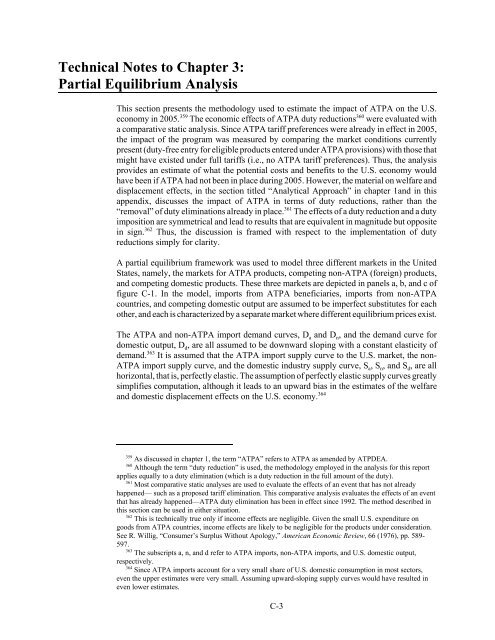The Impact of the Andean Trade Preference Act Twelfth ... - USITC
The Impact of the Andean Trade Preference Act Twelfth ... - USITC
The Impact of the Andean Trade Preference Act Twelfth ... - USITC
- No tags were found...
You also want an ePaper? Increase the reach of your titles
YUMPU automatically turns print PDFs into web optimized ePapers that Google loves.
Technical Notes to Chapter 3:Partial Equilibrium AnalysisThis section presents <strong>the</strong> methodology used to estimate <strong>the</strong> impact <strong>of</strong> ATPA on <strong>the</strong> U.S.economy in 2005. 359 <strong>The</strong> economic effects <strong>of</strong> ATPA duty reductions 360 were evaluated witha comparative static analysis. Since ATPA tariff preferences were already in effect in 2005,<strong>the</strong> impact <strong>of</strong> <strong>the</strong> program was measured by comparing <strong>the</strong> market conditions currentlypresent (duty-free entry for eligible products entered under ATPA provisions) with those thatmight have existed under full tariffs (i.e., no ATPA tariff preferences). Thus, <strong>the</strong> analysisprovides an estimate <strong>of</strong> what <strong>the</strong> potential costs and benefits to <strong>the</strong> U.S. economy wouldhave been if ATPA had not been in place during 2005. However, <strong>the</strong> material on welfare anddisplacement effects, in <strong>the</strong> section titled “Analytical Approach” in chapter 1and in thisappendix, discusses <strong>the</strong> impact <strong>of</strong> ATPA in terms <strong>of</strong> duty reductions, ra<strong>the</strong>r than <strong>the</strong>“removal” <strong>of</strong> duty eliminations already in place. 361 <strong>The</strong> effects <strong>of</strong> a duty reduction and a dutyimposition are symmetrical and lead to results that are equivalent in magnitude but oppositein sign. 362 Thus, <strong>the</strong> discussion is framed with respect to <strong>the</strong> implementation <strong>of</strong> dutyreductions simply for clarity.A partial equilibrium framework was used to model three different markets in <strong>the</strong> UnitedStates, namely, <strong>the</strong> markets for ATPA products, competing non-ATPA (foreign) products,and competing domestic products. <strong>The</strong>se three markets are depicted in panels a, b, and c <strong>of</strong>figure C-1. In <strong>the</strong> model, imports from ATPA beneficiaries, imports from non-ATPAcountries, and competing domestic output are assumed to be imperfect substitutes for eacho<strong>the</strong>r, and each is characterized by a separate market where different equilibrium prices exist.<strong>The</strong> ATPA and non-ATPA import demand curves, D a and D n , and <strong>the</strong> demand curve fordomestic output, D d , are all assumed to be downward sloping with a constant elasticity <strong>of</strong>demand. 363 It is assumed that <strong>the</strong> ATPA import supply curve to <strong>the</strong> U.S. market, <strong>the</strong> non-ATPA import supply curve, and <strong>the</strong> domestic industry supply curve, S a , S n , and S d , are allhorizontal, that is, perfectly elastic. <strong>The</strong> assumption <strong>of</strong> perfectly elastic supply curves greatlysimplifies computation, although it leads to an upward bias in <strong>the</strong> estimates <strong>of</strong> <strong>the</strong> welfareand domestic displacement effects on <strong>the</strong> U.S. economy. 364359 As discussed in chapter 1, <strong>the</strong> term “ATPA” refers to ATPA as amended by ATPDEA.360 Although <strong>the</strong> term “duty reduction” is used, <strong>the</strong> methodology employed in <strong>the</strong> analysis for this reportapplies equally to a duty elimination (which is a duty reduction in <strong>the</strong> full amount <strong>of</strong> <strong>the</strong> duty).361Most comparative static analyses are used to evaluate <strong>the</strong> effects <strong>of</strong> an event that has not alreadyhappened— such as a proposed tariff elimination. This comparative analysis evaluates <strong>the</strong> effects <strong>of</strong> an eventthat has already happened—ATPA duty elimination has been in effect since 1992. <strong>The</strong> method described inthis section can be used in ei<strong>the</strong>r situation.362 This is technically true only if income effects are negligible. Given <strong>the</strong> small U.S. expenditure ongoods from ATPA countries, income effects are likely to be negligible for <strong>the</strong> products under consideration.See R. Willig, “Consumer’s Surplus Without Apology,” American Economic Review, 66 (1976), pp. 589-597.363 <strong>The</strong> subscripts a, n, and d refer to ATPA imports, non-ATPA imports, and U.S. domestic output,respectively.364Since ATPA imports account for a very small share <strong>of</strong> U.S. domestic consumption in most sectors,even <strong>the</strong> upper estimates were very small. Assuming upward-sloping supply curves would have resulted ineven lower estimates.C-3
















